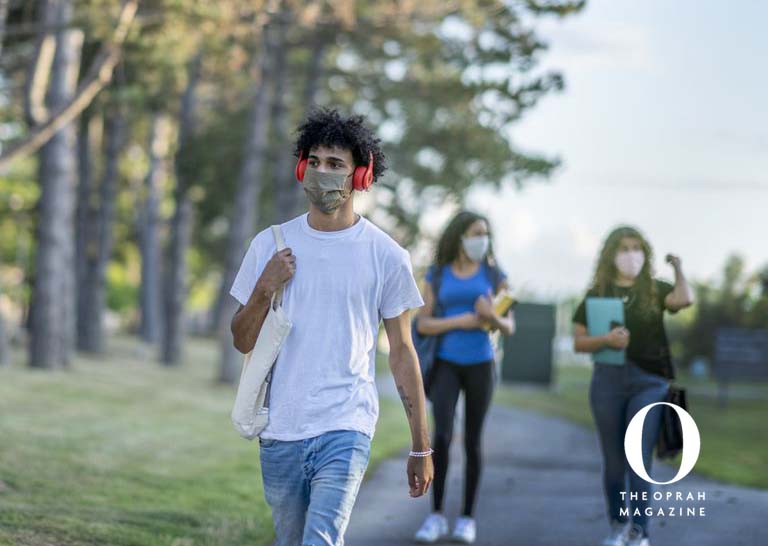Four years ago, as our daughter prepared to leave for college, these were the questions on our minds:
Are microwaves allowed in the dorm?
How much time will we have to move her in?
What in God’s name is a bed topper?
Last month, as we logged onto a pre-college orientation for our son, here’s what parents asked:
How will you enforce mask-wearing for 40,000 students?
What if my child’s roommate does not believe in COVID?
How will students get to the hospital if needed?
What will you say to students who WILL get COVID?
An hour later, my husband and I shut our laptop and stared at each other. Until that moment, we backed our son’s choice, resting our faith in the school’s plan.
Now we had only two questions left: what were we thinking? And were we insane?
Thousands of parents across the country are currently sharing our struggle, as we try to make sense of a situation that, much like everything else right now, feels out of control.
The college class of Class of 2024 in particular has faced a tough ride. First they lost the second semester of their high school senior year, prom, graduation and other school traditions they had awaited since freshman year.
Then, as the pandemic deepened its deadly hold across the country, students were held in limbo while colleges and universities struggled to balance reopening plans with goalposts that kept moving.
In early July, Harvard University announced that all classes in 2020-2021 would be held online—sparking a debate around whether or not the tuition is still worth paying if studies are virtual. Hundreds of schools followed suit in various configurations, many forbidding students back on campus until further notice. As a result, students now face the specter of going to college under circumstances that would have sounded like science fiction just six months ago.
For schools that do allow students on campus, restrictions are severe: most require masks in all inside spaces, while at many schools, dining halls, libraries and gymnasiums are shuttered. Congregating in groups at parties and sporting events—the essence of college life for many—has been stripped away at most schools, replaced by a mandate for students to sign contracts pledging that they will follow the rules, under threat of suspension if they break code.
“For me, it felt like sending my child off to war,” says Maya Bartolf, an education consultant in California whose son, a senior, attends the University of Colorado Boulder. “Saying goodbye never gets easier, but this time I felt more trepidation and dread than the usual excitement of possibilities for him.”
Like Bartolf, many parents have been willing to take a leap of faith regardless of their reservations, but that faith is not always panning out. Last week, Jennifer Krasnoff, a California-based dermatologist, posted the quintessential drop-off picture of her daughter beaming in her newly decorated dorm room.
“Exciting milestone getting Yael settled into her dorm at Colorado College,” Krasnoff wrote. “So proud to see her off on this journey! She’s ready to soar!”
That was on a Friday. Two days later, their daughter called. Someone in the dorm had tested positive for the coronavirus, and now she, along with 155 fellow students, were being sent into a strict two-week quarantine—they weren’t allowed to leave their rooms except to go to the bathroom.
After a tear-filled family Zoom meeting, Krasnoff’s daughter faced the prospect of a year of repeated quarantines. By Monday morning, she had moved out of her dorm and in with a nearby cousin to regroup and plan a gap year off.
As of August 21, only 73 of 3,000 U.S. schools are offering full in-person learning, while 177 schools have gone fully online. 457 have gone hybrid, with a mix of in-person and virtual classes, according to data collected by Davidson College.
As more schools resort to going fully online, parents have been forced to consider the value of college without in-person classes, access to libraries, or sporting and social events. The situation begs the question for many parents: Is such a drastically stripped down version of the college experience worth the cost?
“We are ok with paying full price for a year to get through the pandemic and support CU,” Bartolf says. “However, for a full four year experience, I think not.”
Hali Lee, a New York-based co-director of a philanthropic non-profit organization, has a son who was bound for Princeton University after taking a gap year. After the school recently changed course to go fully virtual, Lee’s son decided take a second gap year.
“The value of going to Princeton is small classes with real professors,” says Lee. “To give up 25 percent of his undergraduate experience to do TV school seems like a waste. But he is going to be an elderly freshman at the age of 20.”
Many other parents are willing to pay full cost, even if their child’s college experience is vastly compromised—or short-lived.
“I keep telling myself that even if she is there for a few weeks, she’ll meet a few people to be in touch with throughout the semester,” says Elizabeth Rozen Silver, an office manager from Connecticut, whose daughter is going to University of Wisconsin-Madison. “At least that way, she may have some sort of community. I’m trying hard to be optimistic, but every day the news from other colleges is getting harder. I am not going to sleep well for however long it lasts.”
Jennifer Harris-Marks is a real estate agent in Northern California, which is currently battling wildfires of historic proportions.
“It’s a sad day when you have to decide whether your child will be better off staying in a state that’s on fire and has no handle on the pandemic…isolated from her peers, or going to a COVID abyss where social distancing will be difficult in order to continue her college education,” Harris-Marks says. “There’s no playbook for this one.”
She says her daughter, however, is clear: “Emily is insisting on going back because she says ‘At least I don’t have to worry about getting my family sick, or killing my grandparents.’”
Many parents felt the choice of whether or not to proceed on schedule with school was not theirs to make, no matter how great their own anxiety.
“We wanted her to write her own story, and this is it,” says Andi Dauer, a Wisconsin-based teacher whose daughter is one of the first in her family to go to college. Although classes are all online, both mother and daughter are undeterred. “This has been her dream since middle school. I am hopeful that COVID won’t send her home early, but we are aware that it’s likely.”
STUDENTS NOW FACE THE SPECTER OF GOING TO COLLEGE UNDER CIRCUMSTANCES THAT WOULD HAVE SOUNDED LIKE SCIENCE FICTION SIX MONTHS AGO.
The threat of their children being infected by the coronavirus is frightening to most parents, but many worry more about the risk to their children’s mental health should they remain at home.
“I don’t feel comfortable at all with my daughter moving into the dorm,” says Sarah Eggers, a school secretary in Wisconsin whose daughter is immunocompromised. “I am concerned about the serious complications from COVID, but in the end, her emotional well-being is the tipping factor, because she likely will not do well if she continues to stay home.”
After watching the impact of the spring and summer quarantine, Linda Finnigan, a health educator in California and parent of an incoming freshman at Cal-Poly Pomona, worries about another aspect of her daughter’s mental health.
“My daughter took it all very seriously,” Finnigan says. “She followed every precaution while her friends did not change their lives one iota. They’d go off to the beach, have parties. She lost all of her social life. She felt punished for being safe. It was heartbreaking.”
Although Finnigan is hopeful that her daughter will find her way, she is concerned that she will face a similar situation in college. “What I worry about is her mental state. I don’t want her to be deemed a social outcast for following the rules when the people around her are acting irresponsibly.”
The kind of peer pressure that Finnigan speaks of can be accentuated for students living in the fraternities and sororities that remain open.
Lisa Levin is a librarian from California. Her son, a junior at University of Wisconsin-Madison, contracted COVID-19 just a few days into summer school, along with 19 other members living at the fraternity house at the time.
Thankfully, his case was mild and no one was hospitalized, but Levin’s son has yet to fully regain his sense of smell, and there is no guarantee that he won’t suffer any long term effects. And because so little is known about immunity to the virus, Levin is also concerned about reinfection.
“I worry about him constantly,” Levin says. “And I feel sad for our kids. These are the years that life is about socializing and being together. And now, they can’t do anything, and if they do, they’re really taking chances.”
Parents in minority communities face an additional burden while their children leave for school.
Last week, Beatrice Springs, a Red Cross employee in North Carolina, dropped her daughter off at Winston-Salem State University, a member of the Historically Black Colleges Universities.
Springs is not overly concerned about her own daughter, who is conscientious and has been working outside the home since she left school last spring. But as evidence mounts that people of color suffer a disproportionate incidence of serious COVID-related complications and death, increasingly she worries about her community.
“As African Americans, we are more conservative during times like these, because we have always had to manage the aftermath,” Springs says. “We do what we’re supposed to do to protect ourselves, so that we won’t be a statistic. Going to the beach, having big parties? We’re not doing that stuff, because a lot of us can’t afford the risk.”
Students who are differently-abled, meanwhile, face their own set of issues.
Connecticut-based Brian and Laurie Reich, a retired transportation broker and sales executive respectively, are preparing to move their daughter, Sydney, into her graduate school housing at Northeastern University.
Reich, who has cerebral palsy, has round-the-clock assistance for most physical aspects of her life. “I have people touching me all day every day,” she says. “So I’m more exposed, more at risk of getting the virus. But I’m not afraid. If I lived my life afraid, I wouldn’t be doing all the things I’m doing.”
Despite the increased risk to their daughter, Sydney’s parents support her wish to leave for school. “She’s tired of home,” her father explains. “She wants to be out on her own in the world. The problem for all our college kids is that it’s like putting a carrot in front of a horse. It’s all right there, but they can’t do any of it. All they can do is keep hoping that tomorrow will be different.”
While the coronavirus has robbed students of nearly every normal aspect of life on campus, the pandemic delivers an especially bitter pill for student athletes. Becky Gamble, a Vermont-based writer, has a senior at Wesleyan University and a junior at Vassar College, both of whom are subject to pre-school quarantines, quarantines upon arrival, testing twice a week, and a requirement to report daily symptoms on an app. One son is a three-season athlete. Fall sports have been canceled and spring sports are in serious question.
“He is immensely sad about this,” Becky Gamble says. “I vacillate between being excited that they are taking part in this grand experiment to being very anxious about the viability of the plans for the entire semester.”
Still, Gamble says, she and her husband are supportive. “We think that returning, even if it’s short-lived, is critical for their mental health. We see the toll it has taken thus far and know it’s in their best interest to give it a shot. They always bounce back, but I’m not sure how one bounces from all of this.”
Beyond the loss of sports and normalcy lurks every parent’s ultimate fear: losing one’s child. Leah Johnson, a recruiter from Wisconsin whose son is a first generation college student, says he is “ready to face whatever gets thrown at him and make his own path in life. But our worst fear is that he gets sick and dies.”
Many parents echoed the same fear, but emphasized their commitment to remaining optimistic about their children’s path. “We choose not to spend our lives dwelling on the what-ifs,” Johnson says. “We want to focus on the future while taking what we feel are appropriate precautions and risks.”
While parents work to manage their anxiety in order to support their children, some expressed worry about the long term consequences of all the restrictions, anxiety and uncertainty ahead.
“Going to school is a rite of passage,” Finnigan says. “All that interaction? They’re getting cheated out of it all. I’m worried about the fact that mortality is more in their face. I’m worried that they they’ll lose their sense of adventure, that feeling of youth, of being a free spirit. If nothing changes, I’m worried that these kids are going to stop maturing because they didn’t get what should have been a carefree time in their lives.”
As for our son? He’ll take a gap year and live in Evanston, Illinois with our daughter, a recent college graduate whose plans have also been put on hold for the foreseeable future. We are hopeful they will both find work and some meaning out of a year defined by a country in crisis…but who knows?
In the end, there seems to be only one clear truth.
“It’s tough for everyone in this unknown world right now,” says Eileen Kershenbaum, an occupational therapist from Kansas whose daughter is at University of Miami. “There is no universal right answer.”
This article was originally published in The Oprah Magazine.





